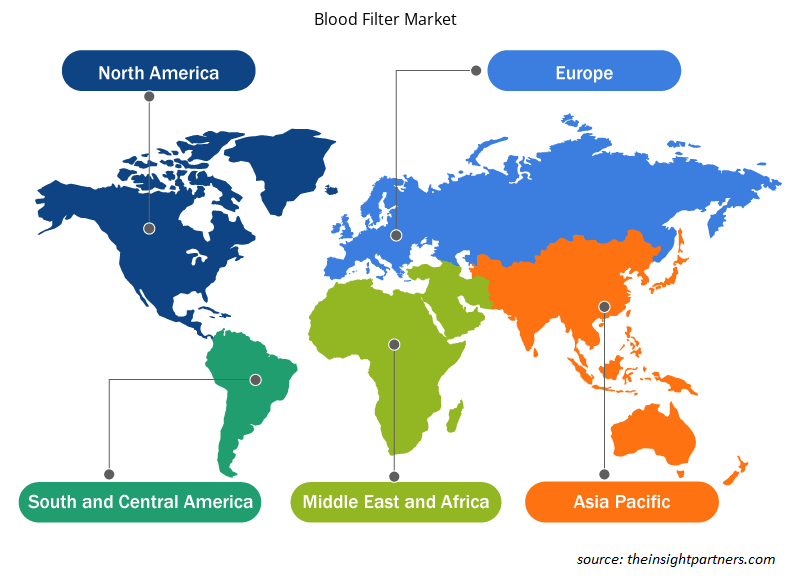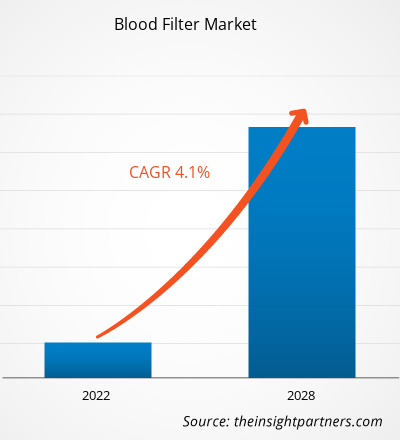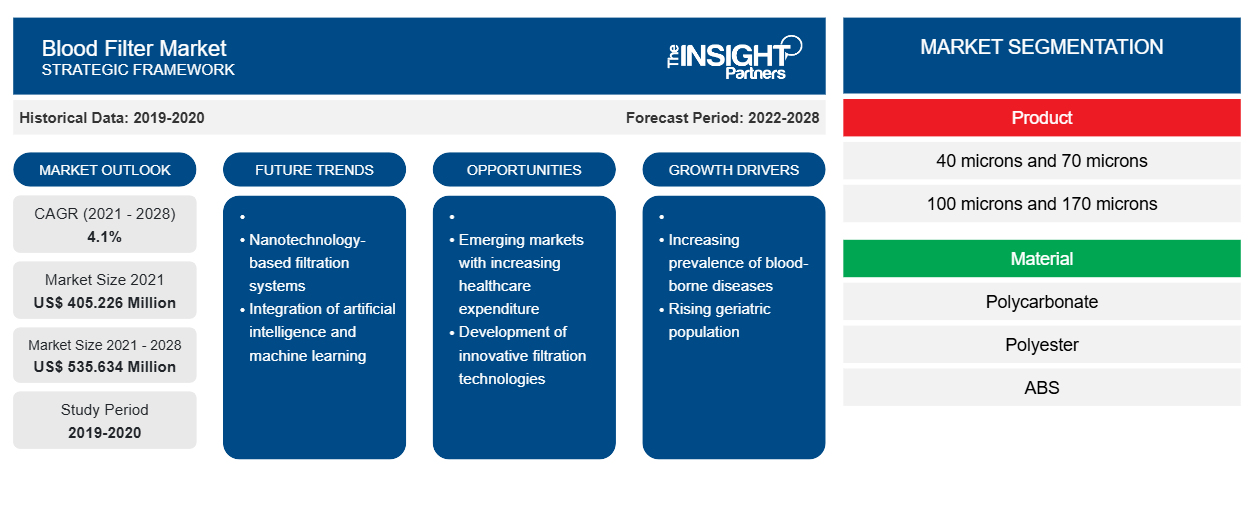من المتوقع أن يصل سوق فلتر الدم إلى 535.634 مليون دولار أمريكي بحلول عام 2028 من 405.226 مليون دولار أمريكي في عام 2021؛ ومن المتوقع أن ينمو بمعدل نمو سنوي مركب قدره 4.1٪ من عام 2021 إلى عام 2028.
مرشح الدم هو مرشح من نوع الشاشة يتكون من شبكة منسوجة مصنوعة من البوليستر أو النايلون، ويتم وضعه بين كيس المنتج والمريض لإجراء الترشيح. تهدف هذه المرشحات إلى حماية المرضى من التجمعات الكبيرة والجسيمات غير المكونة للدم والتي قد تكون خطرة إذا دخلت مجرى الدم. إنها تزيل التجمعات الكبيرة مثل مواقع التجمعات الدقيقة وتجمعات الفيبرين أثناء نقل الدم . تتضمن الترشيح التقاط الجسيمات والتجمعات الكبيرة المكونة من كريات الدم البيضاء والفيبرين والصفائح الدموية، والتي تشكلت أثناء تخزين الدم. عوامل مثل زيادة عبء الأمراض المزمنة، وزيادة حالات الصدمات والحوادث، والعدد المتزايد من إجراءات نقل الدم تدفع نمو سوق مرشح الدم . ومع ذلك، فإن سحب المنتجات يعيق نمو السوق.
قم بتخصيص هذا التقرير ليناسب متطلباتك
ستحصل على تخصيص لأي تقرير - مجانًا - بما في ذلك أجزاء من هذا التقرير، أو تحليل على مستوى الدولة، وحزمة بيانات Excel، بالإضافة إلى الاستفادة من العروض والخصومات الرائعة للشركات الناشئة والجامعات
- احصل على أهم اتجاهات السوق الرئيسية لهذا التقرير.ستتضمن هذه العينة المجانية تحليلاً للبيانات، بدءًا من اتجاهات السوق وحتى التقديرات والتوقعات.
رؤى السوق
ارتفاع عدد عمليات نقل الدم يعزز نمو سوق مرشحات الدم
إن تحسين توافر الدم الآمن والكافي لعمليات نقل الدم يجب أن يكون جزءًا لا يتجزأ من سياسة الرعاية الصحية الوطنية والبنية الأساسية في كل بلد. وقد تنشأ الحاجة إلى نقل الدم في أي وقت في المناطق الحضرية والريفية. في الماضي، أدى عدم توافر الدم إلى وفاة العديد من المرضى الذين يعانون من سوء الصحة. يمكن ضمان إمداد كافٍ وموثوق به من الدم الآمن من خلال وجود مرافق مستقرة للمتبرعين بالدم المنتظمين والطوعيين وغير المدفوعين. وهم أيضًا أكثر مجموعة من المتبرعين أمانًا حيث أن انتشار العدوى المنقولة بالدم هو الأقل بين هؤلاء المتبرعين.
تشمل العمليات الجراحية الأكثر شيوعًا التي تتطلب نقل الدم الإجراءات القلبية الوعائية، وإجراءات الولادة القيصرية، والإصابات. وفقًا لتقديرات المعهد الوطني للقلب والرئة والدم، والمعاهد الوطنية للصحة (NIH)، في الولايات المتحدة، يحتاج أكثر من 5 ملايين شخص إلى نقل الدم كل عام. علاوة على ذلك، بسبب الكوارث الطبيعية والإصابات المنتشرة، يتزايد الطلب على نقل الدم في جميع أنحاء العالم. كما أن الارتفاع في حالات اضطرابات الدم مثل فقر الدم، وزيادة كريات الدم الحمراء، وزيادة كريات الدم البيضاء، وقلة الكريات البيض، وكثرة الصفيحات الدموية يعزز أيضًا نمو سوق مرشحات الدم. وفقًا لمنظمة الصحة العالمية، يولد معظم الأطفال المصابين بالثلاسيميا في البلدان ذات الدخل المنخفض، حيث يكون الوصول إلى نقل الدم صعبًا أو متاحًا لنسبة صغيرة من السكان.
مرشحات الدم المستخدمة في إجراءات نقل الدم عبارة عن شبكة منسوجة مصنوعة من البوليستر أو النايلون؛ وهي عبارة عن مرشحات من نوع الشاشة توضع بين كيس المنتج والمريض. تم تصميم هذه المرشحات لحماية المرضى من التجمعات الكبيرة الضارة المحتملة مثل الصفائح الدموية وكريات الدم البيضاء وبروتينات الفيبرين والجسيمات غير المكونة للدم. في غالبية البلدان المتقدمة، يتم توفير مرشحات نقل الدم من قبل الحكومات أو البرامج المجتمعية. وبالتالي، فإن توافر المرافق المناسبة للتبرع بالدم والتبرع الطوعي يدفع عدد إجراءات نقل الدم، مما يعزز نمو سوق حشو الدم.
رؤى قائمة على المنتج
بناءً على المنتج، يتم تقسيم سوق مرشحات الدم إلى 40 ميكرون و70 ميكرون و100 ميكرون و170 ميكرون وغيرها. من المتوقع أن تحتل شريحة 100 ميكرون و170 ميكرون أكبر حصة في السوق في عام 2021 ومن المتوقع أن تسجل معدل نمو سنوي مركب أعلى خلال الفترة المتوقعة.
رؤى قائمة على المواد
بناءً على المادة، يتم تقسيم سوق مرشحات الدم إلى البولي كربونات والبوليستر وABS وغيرها. من المتوقع أن يحتفظ قطاع البوليستر بأكبر حصة سوقية بنسبة 35.47% في عام 2021، ومن المتوقع أن يحتفظ بهيمنته خلال الفترة المتوقعة.
رؤى قائمة على التطبيق
بناءً على التطبيق، يتم تقسيم سوق مرشحات الدم إلى معالجة الدم ونقل الدم. من المتوقع أن يحتفظ قطاع نقل الدم بأكبر حصة سوقية بنسبة 73.83% في عام 2021، ومن المتوقع أن يحتفظ بهيمنته خلال الفترة المتوقعة.
رؤى تعتمد على المستخدم النهائي
بناءً على المستخدم النهائي، يتم تقسيم سوق مرشحات الدم إلى بنوك الدم والمستشفيات وغيرها. من المتوقع أن يحتفظ قطاع بنوك الدم بأكبر حصة سوقية بنسبة 47.38% في عام 2021 ومن المتوقع أن يحتفظ بهيمنته خلال الفترة المتوقعة.
تتبنى العديد من الشركات العاملة في سوق فلتر الدم استراتيجيات مثل إطلاق المنتجات، وعمليات الدمج والاستحواذ، والتعاون، وابتكار المنتجات، وتوسيع محفظة المنتجات لتوسيع بصمتها في جميع أنحاء العالم، والحفاظ على اسم العلامة التجارية، وتلبية الطلب المتزايد من المستخدمين النهائيين.
رؤى إقليمية حول سوق مرشحات الدم
لقد قام المحللون في Insight Partners بشرح الاتجاهات والعوامل الإقليمية المؤثرة على سوق مرشحات الدم طوال فترة التوقعات بشكل شامل. يناقش هذا القسم أيضًا قطاعات سوق مرشحات الدم والجغرافيا في جميع أنحاء أمريكا الشمالية وأوروبا ومنطقة آسيا والمحيط الهادئ والشرق الأوسط وأفريقيا وأمريكا الجنوبية والوسطى.

- احصل على البيانات الإقليمية المحددة لسوق فلتر الدم
نطاق تقرير سوق مرشحات الدم
| سمة التقرير | تفاصيل |
|---|---|
| حجم السوق في عام 2021 | 405.226 مليون دولار أمريكي |
| حجم السوق بحلول عام 2028 | 535.634 مليون دولار أمريكي |
| معدل النمو السنوي المركب العالمي (2021 - 2028) | 4.1% |
| البيانات التاريخية | 2019-2020 |
| فترة التنبؤ | 2022-2028 |
| القطاعات المغطاة | حسب المنتج
|
| المناطق والدول المغطاة | أمريكا الشمالية
|
| قادة السوق وملفات تعريف الشركات الرئيسية |
|
كثافة اللاعبين في سوق مرشحات الدم: فهم تأثيرها على ديناميكيات الأعمال
يشهد سوق مرشحات الدم نموًا سريعًا، مدفوعًا بالطلب المتزايد من المستخدم النهائي بسبب عوامل مثل تفضيلات المستهلك المتطورة والتقدم التكنولوجي والوعي المتزايد بفوائد المنتج. ومع ارتفاع الطلب، تعمل الشركات على توسيع عروضها والابتكار لتلبية احتياجات المستهلكين والاستفادة من الاتجاهات الناشئة، مما يؤدي إلى زيادة نمو السوق.
تشير كثافة اللاعبين في السوق إلى توزيع الشركات أو المؤسسات العاملة في سوق أو صناعة معينة. وهي تشير إلى عدد المنافسين (اللاعبين في السوق) الموجودين في مساحة سوق معينة نسبة إلى حجمها أو قيمتها السوقية الإجمالية.
الشركات الرئيسية العاملة في سوق فلتر الدم هي:
- شركة أساهي كاساي
- شركة فريسينيوس كابي ايه جي
- ماكوفارما
- شركة هيمونيتيك
- معلومات عن جنوب أفريقيا
إخلاء المسؤولية : الشركات المذكورة أعلاه ليست مرتبة بأي ترتيب معين.

- احصل على نظرة عامة على أهم اللاعبين الرئيسيين في سوق مرشحات الدم
سوق مرشحات الدم – حسب المنتج
- 40 ميكرون و 70 ميكرون
- 100 ميكرون و 170 ميكرون
- آحرون
سوق فلتر الدم – حسب المادة
- بولي كربونات
- البوليستر
- نظام ABS
- آحرون
سوق مرشحات الدم – حسب التطبيق
- معالجة الدم
- نقل الدم
سوق مرشحات الدم – حسب المستخدم النهائي
- بنوك الدم
- المستشفيات
- آحرون
سوق فلتر الدم – حسب المنطقة الجغرافية
- أمريكا الشمالية
- نحن
- كندا
- المكسيك
- أوروبا
- فرنسا
- ألمانيا
- إيطاليا
- المملكة المتحدة
- إسبانيا
- بقية أوروبا
- آسيا والمحيط الهادئ (APAC)
- الصين
- الهند
- كوريا الجنوبية
- اليابان
- أستراليا
- بقية آسيا والمحيط الهادئ
- الشرق الأوسط وأفريقيا
- جنوب أفريقيا
- المملكة العربية السعودية
- الامارات العربية المتحدة
- بقية الشرق الأوسط وأفريقيا
- أمريكا الجنوبية والوسطى (احتيال)
- البرازيل
- الأرجنتين
- بقية أمريكا الجنوبية والوسطى
نبذة عن الشركة
- شركة أساهي كاساي
- شركة فريسينيوس كابي ايه جي
- ماكوفارما
- شركة هيمونيتيك
- معلومات عن جنوب أفريقيا
- شركة كانيكا
- مختبرات كاواسومي المحدودة
- شركة سفر ايه جي
- شركة شاندونج تشونج باو كانج للأدوات الطبية المحدودة
- نانجينغ شوانجوي للتكنولوجيا الحيوية المحدودة
- التحليل التاريخي (سنتان)، سنة الأساس، التوقعات (7 سنوات) مع معدل النمو السنوي المركب
- تحليل PEST و SWOT
- حجم السوق والقيمة / الحجم - عالمي، إقليمي، بلد
- الصناعة والمنافسة
- مجموعة بيانات إكسل
التقارير الحديثة
تقارير ذات صلة
شهادات العملاء
سبب الشراء
- اتخاذ قرارات مدروسة
- فهم ديناميكيات السوق
- تحليل المنافسة
- رؤى العملاء
- توقعات السوق
- تخفيف المخاطر
- التخطيط الاستراتيجي
- مبررات الاستثمار
- تحديد الأسواق الناشئة
- تحسين استراتيجيات التسويق
- تعزيز الكفاءة التشغيلية
- مواكبة التوجهات التنظيمية





















 احصل على عينة مجانية ل - سوق فلتر الدم
احصل على عينة مجانية ل - سوق فلتر الدم